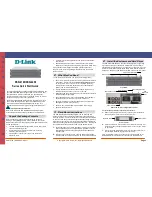
3Com Switch 8800 Configuration Guide
Chapter 21 BGP Configuration
21-1
Chapter 21 BGP Configuration
21.1 BGP/MBGP Overview
21.1.1 Introduction to BGP
Border gateway protocol (BGP) is an inter-autonomous system (inter-AS) dynamic
route discovery protocol. Three early versions of BGP are BGP-1 (RFC1105), BGP-2
(RFC1163) and BGP-3 (RFC1267). The current version is BGP-4 (RFC1771) that is
applied to advertised structures and supports classless inter-domain routing (CIDR).
Actually, BGP-4 is becoming the external routing protocol standard of the Internet,
which is frequently used between ISPs.
The characteristics of BGP are as follows:
z
BGP is an external gateway protocol (EGP). Different from such internal routing
protocols as OSPF and RIP, it focuses on route propagation control and selection
of best routes other than discovery and calculation of routes.
z
It eliminates routing loop by adding AS path information to BGP routes.
z
It enhances its own reliability by using TCP as the transport layer protocol.
z
When routes are updated, BGP only transmits updated routes, which greatly
reduces bandwidth occupation by route propagation and can be applied to
propagation of a great amount of routing information on the Internet.
z
BGP-4 supports CIDR, which is an important improvement to BGP-3.
z
In consideration of management and security, users desire to perform control over
outgoing and incoming routing information of each AS. BGP-4 provides abundant
route policies to implement flexible filtering and selecting of routes.
z
BGP-4 can be extended easily to support new developments of the network.
Note:
z
CIDR handles IP addresses in an entirely new way, that is, it does not distinguish
networks of Class A, Class B and Class C. For example, an invalid Class C network
address 192.213.0.0 (255.255.0.0) can be expressed as 192.213.0.0/16 in CIDR
mode, which is a valid super network. Here /16 means that the subnet mask is
composed of the first 16 bits from the left.
z
The introduction of CIDR simplifies route aggregation. Actually, route aggregation is
the process of aggregating several different routes, which turns advertisement
processes of several routes to the advertisement of single route so as to simplify the
routing table.
















































